Management Accounting Report: GSQ Financial Analysis and Costing
VerifiedAdded on 2023/01/12
|14
|3916
|77
Report
AI Summary
This report provides a comprehensive analysis of management accounting concepts, systems, and reporting methods. It delves into the preparation of income statements using marginal and absorption costing techniques, demonstrating their application through examples. The report also explores various management accounting reporting methods, budgetary control tools, and their advantages and disadvantages. Furthermore, it examines the adaptation of different management accounting tools to solve financial problems, using GSQ Limited as a case study to illustrate the practical application of these concepts. The report emphasizes how companies can achieve sustainable success by effectively addressing financial challenges through informed decision-making and strategic financial planning. Excel is utilized for the calculation of costs like production cost per unit etc.
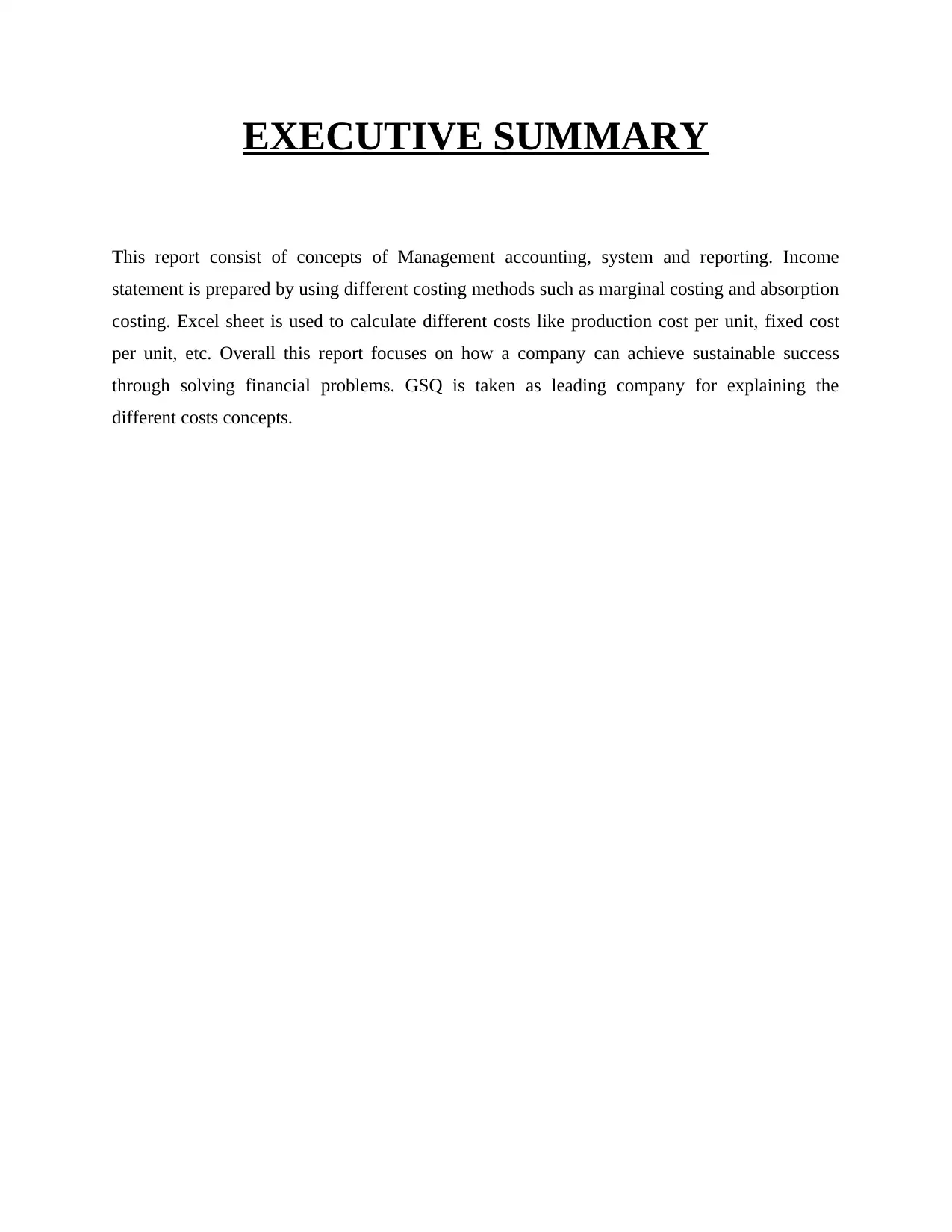
EXECUTIVE SUMMARY
This report consist of concepts of Management accounting, system and reporting. Income
statement is prepared by using different costing methods such as marginal costing and absorption
costing. Excel sheet is used to calculate different costs like production cost per unit, fixed cost
per unit, etc. Overall this report focuses on how a company can achieve sustainable success
through solving financial problems. GSQ is taken as leading company for explaining the
different costs concepts.
This report consist of concepts of Management accounting, system and reporting. Income
statement is prepared by using different costing methods such as marginal costing and absorption
costing. Excel sheet is used to calculate different costs like production cost per unit, fixed cost
per unit, etc. Overall this report focuses on how a company can achieve sustainable success
through solving financial problems. GSQ is taken as leading company for explaining the
different costs concepts.
Paraphrase This Document
Need a fresh take? Get an instant paraphrase of this document with our AI Paraphraser
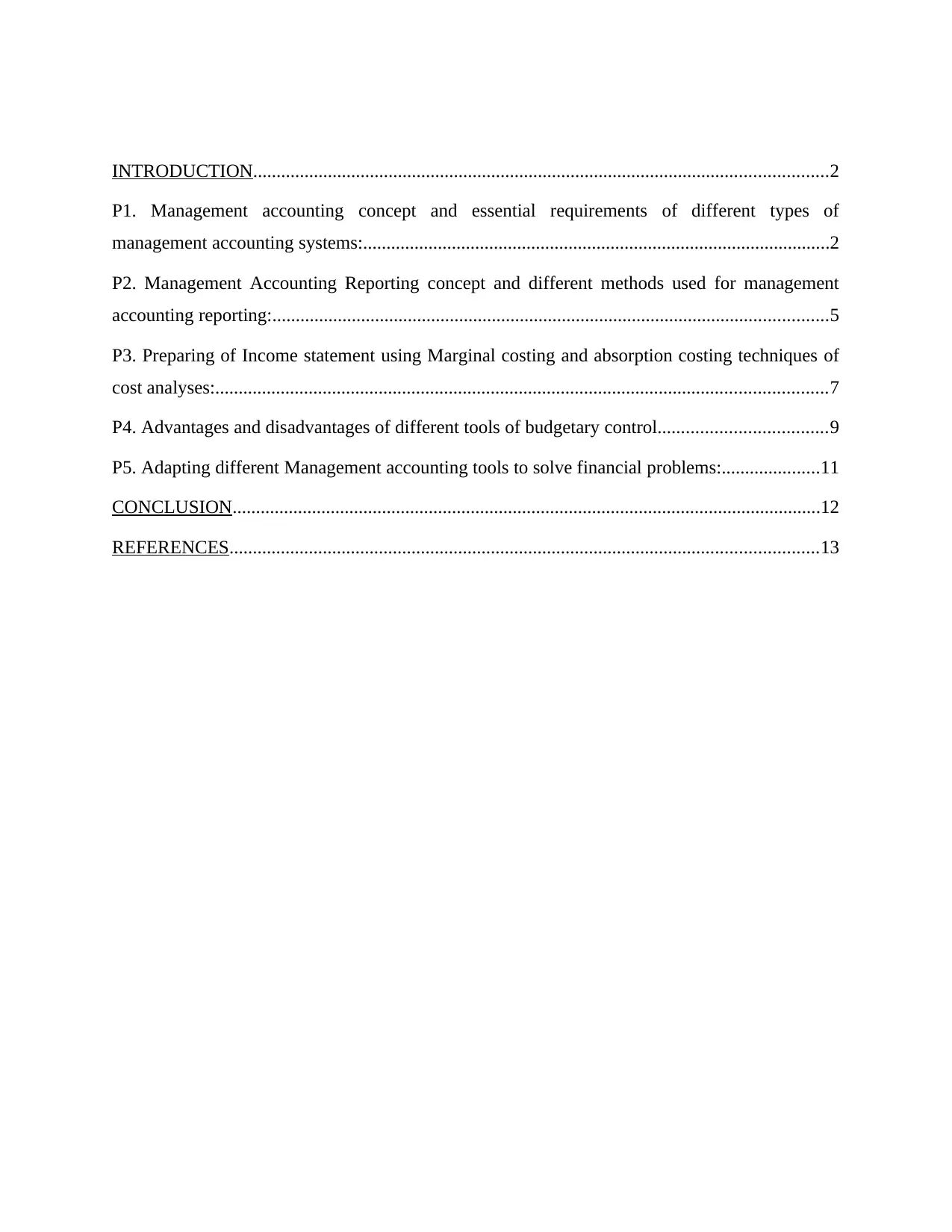
INTRODUCTION...........................................................................................................................2
P1. Management accounting concept and essential requirements of different types of
management accounting systems:....................................................................................................2
P2. Management Accounting Reporting concept and different methods used for management
accounting reporting:.......................................................................................................................5
P3. Preparing of Income statement using Marginal costing and absorption costing techniques of
cost analyses:...................................................................................................................................7
P4. Advantages and disadvantages of different tools of budgetary control....................................9
P5. Adapting different Management accounting tools to solve financial problems:.....................11
CONCLUSION..............................................................................................................................12
REFERENCES..............................................................................................................................13
P1. Management accounting concept and essential requirements of different types of
management accounting systems:....................................................................................................2
P2. Management Accounting Reporting concept and different methods used for management
accounting reporting:.......................................................................................................................5
P3. Preparing of Income statement using Marginal costing and absorption costing techniques of
cost analyses:...................................................................................................................................7
P4. Advantages and disadvantages of different tools of budgetary control....................................9
P5. Adapting different Management accounting tools to solve financial problems:.....................11
CONCLUSION..............................................................................................................................12
REFERENCES..............................................................................................................................13
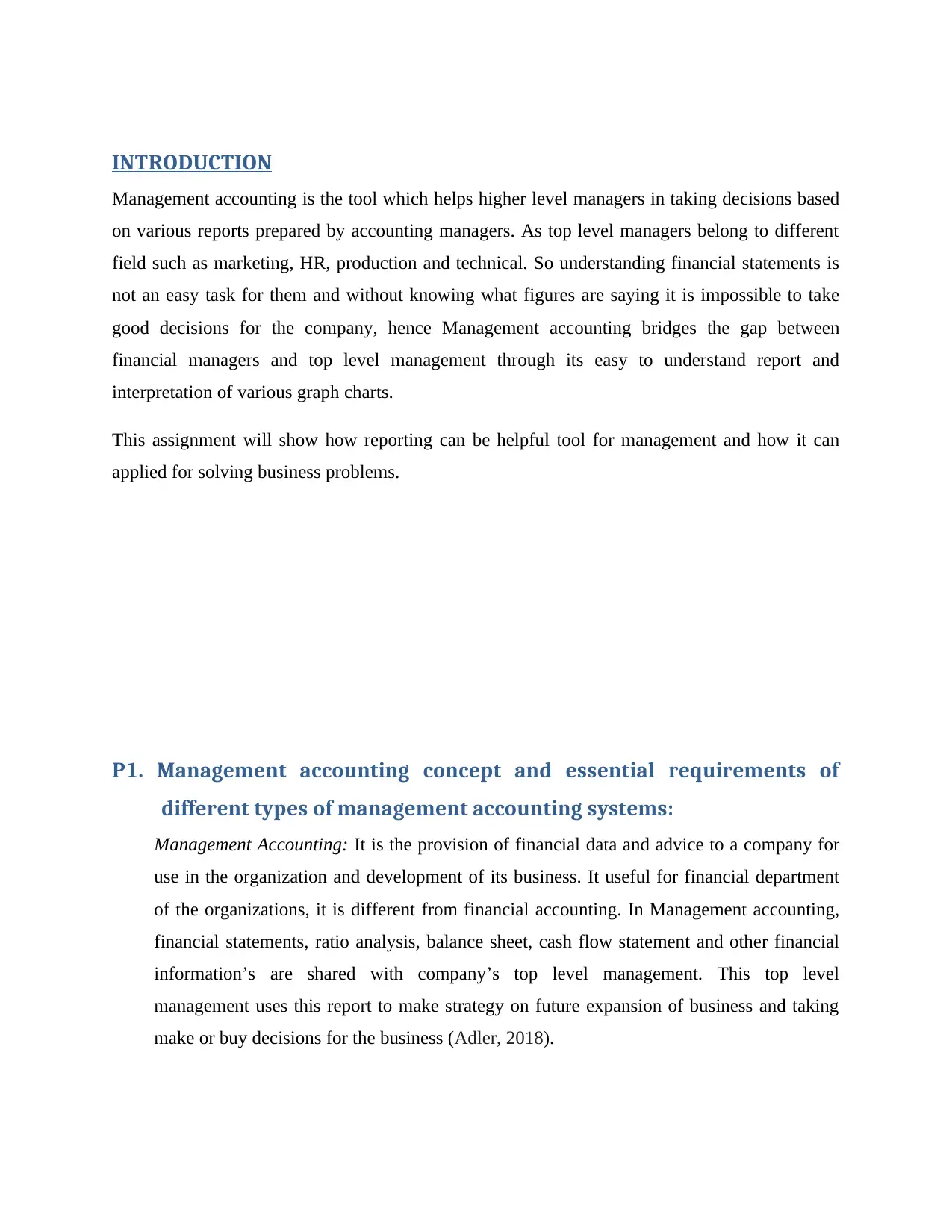
INTRODUCTION
Management accounting is the tool which helps higher level managers in taking decisions based
on various reports prepared by accounting managers. As top level managers belong to different
field such as marketing, HR, production and technical. So understanding financial statements is
not an easy task for them and without knowing what figures are saying it is impossible to take
good decisions for the company, hence Management accounting bridges the gap between
financial managers and top level management through its easy to understand report and
interpretation of various graph charts.
This assignment will show how reporting can be helpful tool for management and how it can
applied for solving business problems.
P1. Management accounting concept and essential requirements of
different types of management accounting systems:
Management Accounting: It is the provision of financial data and advice to a company for
use in the organization and development of its business. It useful for financial department
of the organizations, it is different from financial accounting. In Management accounting,
financial statements, ratio analysis, balance sheet, cash flow statement and other financial
information’s are shared with company’s top level management. This top level
management uses this report to make strategy on future expansion of business and taking
make or buy decisions for the business (Adler, 2018).
Management accounting is the tool which helps higher level managers in taking decisions based
on various reports prepared by accounting managers. As top level managers belong to different
field such as marketing, HR, production and technical. So understanding financial statements is
not an easy task for them and without knowing what figures are saying it is impossible to take
good decisions for the company, hence Management accounting bridges the gap between
financial managers and top level management through its easy to understand report and
interpretation of various graph charts.
This assignment will show how reporting can be helpful tool for management and how it can
applied for solving business problems.
P1. Management accounting concept and essential requirements of
different types of management accounting systems:
Management Accounting: It is the provision of financial data and advice to a company for
use in the organization and development of its business. It useful for financial department
of the organizations, it is different from financial accounting. In Management accounting,
financial statements, ratio analysis, balance sheet, cash flow statement and other financial
information’s are shared with company’s top level management. This top level
management uses this report to make strategy on future expansion of business and taking
make or buy decisions for the business (Adler, 2018).
⊘ This is a preview!⊘
Do you want full access?
Subscribe today to unlock all pages.

Trusted by 1+ million students worldwide
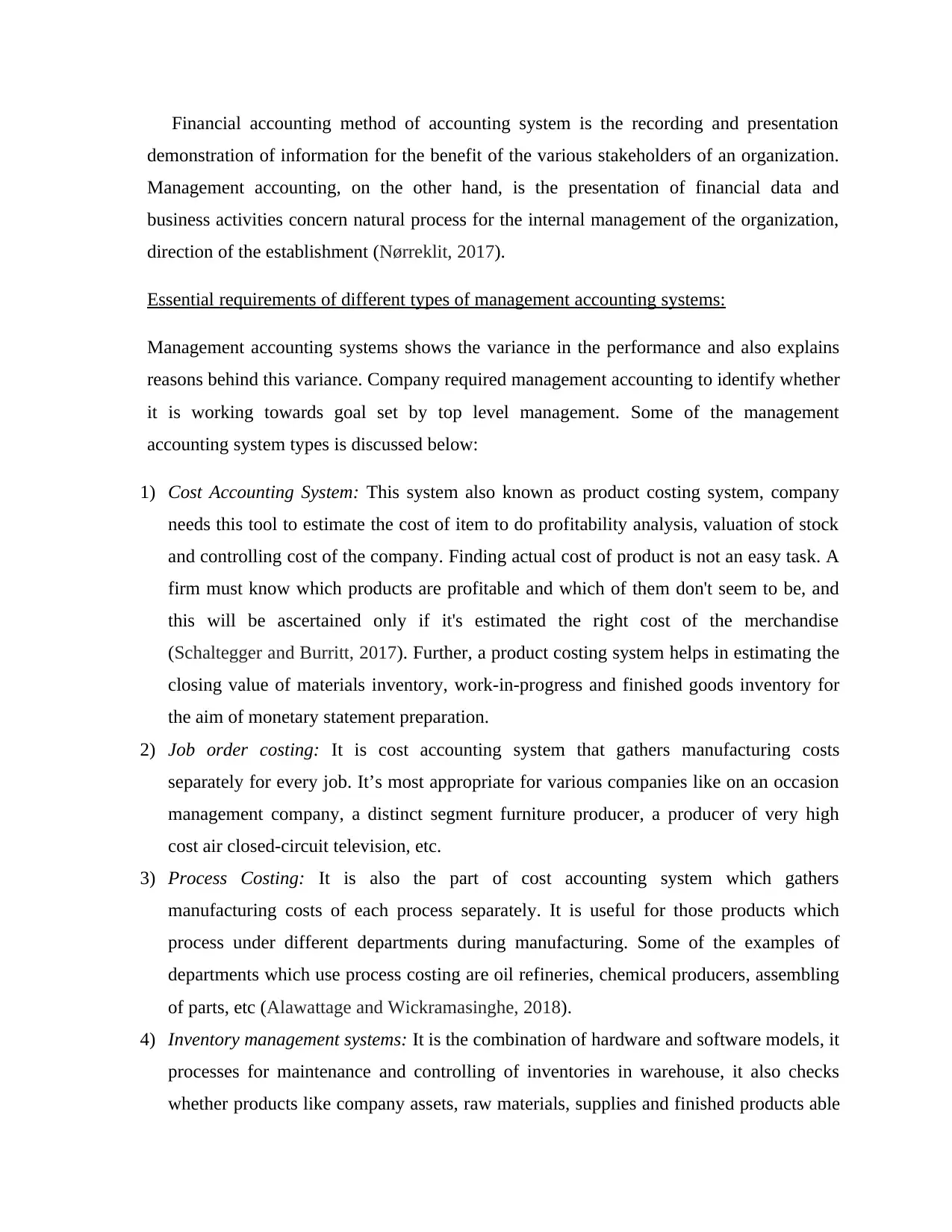
Financial accounting method of accounting system is the recording and presentation
demonstration of information for the benefit of the various stakeholders of an organization.
Management accounting, on the other hand, is the presentation of financial data and
business activities concern natural process for the internal management of the organization,
direction of the establishment (Nørreklit, 2017).
Essential requirements of different types of management accounting systems:
Management accounting systems shows the variance in the performance and also explains
reasons behind this variance. Company required management accounting to identify whether
it is working towards goal set by top level management. Some of the management
accounting system types is discussed below:
1) Cost Accounting System: This system also known as product costing system, company
needs this tool to estimate the cost of item to do profitability analysis, valuation of stock
and controlling cost of the company. Finding actual cost of product is not an easy task. A
firm must know which products are profitable and which of them don't seem to be, and
this will be ascertained only if it's estimated the right cost of the merchandise
(Schaltegger and Burritt, 2017). Further, a product costing system helps in estimating the
closing value of materials inventory, work-in-progress and finished goods inventory for
the aim of monetary statement preparation.
2) Job order costing: It is cost accounting system that gathers manufacturing costs
separately for every job. It’s most appropriate for various companies like on an occasion
management company, a distinct segment furniture producer, a producer of very high
cost air closed-circuit television, etc.
3) Process Costing: It is also the part of cost accounting system which gathers
manufacturing costs of each process separately. It is useful for those products which
process under different departments during manufacturing. Some of the examples of
departments which use process costing are oil refineries, chemical producers, assembling
of parts, etc (Alawattage and Wickramasinghe, 2018).
4) Inventory management systems: It is the combination of hardware and software models, it
processes for maintenance and controlling of inventories in warehouse, it also checks
whether products like company assets, raw materials, supplies and finished products able
demonstration of information for the benefit of the various stakeholders of an organization.
Management accounting, on the other hand, is the presentation of financial data and
business activities concern natural process for the internal management of the organization,
direction of the establishment (Nørreklit, 2017).
Essential requirements of different types of management accounting systems:
Management accounting systems shows the variance in the performance and also explains
reasons behind this variance. Company required management accounting to identify whether
it is working towards goal set by top level management. Some of the management
accounting system types is discussed below:
1) Cost Accounting System: This system also known as product costing system, company
needs this tool to estimate the cost of item to do profitability analysis, valuation of stock
and controlling cost of the company. Finding actual cost of product is not an easy task. A
firm must know which products are profitable and which of them don't seem to be, and
this will be ascertained only if it's estimated the right cost of the merchandise
(Schaltegger and Burritt, 2017). Further, a product costing system helps in estimating the
closing value of materials inventory, work-in-progress and finished goods inventory for
the aim of monetary statement preparation.
2) Job order costing: It is cost accounting system that gathers manufacturing costs
separately for every job. It’s most appropriate for various companies like on an occasion
management company, a distinct segment furniture producer, a producer of very high
cost air closed-circuit television, etc.
3) Process Costing: It is also the part of cost accounting system which gathers
manufacturing costs of each process separately. It is useful for those products which
process under different departments during manufacturing. Some of the examples of
departments which use process costing are oil refineries, chemical producers, assembling
of parts, etc (Alawattage and Wickramasinghe, 2018).
4) Inventory management systems: It is the combination of hardware and software models, it
processes for maintenance and controlling of inventories in warehouse, it also checks
whether products like company assets, raw materials, supplies and finished products able
Paraphrase This Document
Need a fresh take? Get an instant paraphrase of this document with our AI Paraphraser
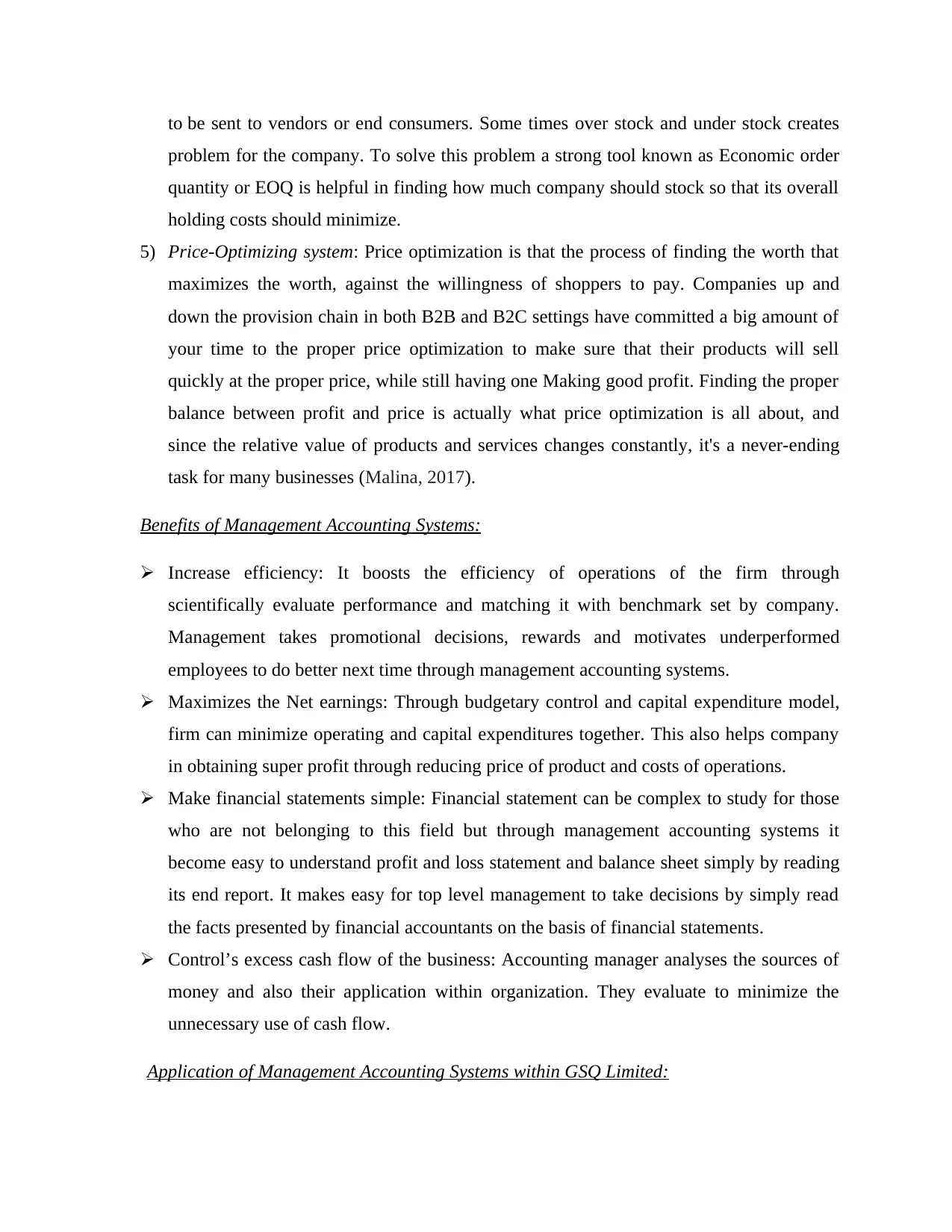
to be sent to vendors or end consumers. Some times over stock and under stock creates
problem for the company. To solve this problem a strong tool known as Economic order
quantity or EOQ is helpful in finding how much company should stock so that its overall
holding costs should minimize.
5) Price-Optimizing system: Price optimization is that the process of finding the worth that
maximizes the worth, against the willingness of shoppers to pay. Companies up and
down the provision chain in both B2B and B2C settings have committed a big amount of
your time to the proper price optimization to make sure that their products will sell
quickly at the proper price, while still having one Making good profit. Finding the proper
balance between profit and price is actually what price optimization is all about, and
since the relative value of products and services changes constantly, it's a never-ending
task for many businesses (Malina, 2017).
Benefits of Management Accounting Systems:
Increase efficiency: It boosts the efficiency of operations of the firm through
scientifically evaluate performance and matching it with benchmark set by company.
Management takes promotional decisions, rewards and motivates underperformed
employees to do better next time through management accounting systems.
Maximizes the Net earnings: Through budgetary control and capital expenditure model,
firm can minimize operating and capital expenditures together. This also helps company
in obtaining super profit through reducing price of product and costs of operations.
Make financial statements simple: Financial statement can be complex to study for those
who are not belonging to this field but through management accounting systems it
become easy to understand profit and loss statement and balance sheet simply by reading
its end report. It makes easy for top level management to take decisions by simply read
the facts presented by financial accountants on the basis of financial statements.
Control’s excess cash flow of the business: Accounting manager analyses the sources of
money and also their application within organization. They evaluate to minimize the
unnecessary use of cash flow.
Application of Management Accounting Systems within GSQ Limited:
problem for the company. To solve this problem a strong tool known as Economic order
quantity or EOQ is helpful in finding how much company should stock so that its overall
holding costs should minimize.
5) Price-Optimizing system: Price optimization is that the process of finding the worth that
maximizes the worth, against the willingness of shoppers to pay. Companies up and
down the provision chain in both B2B and B2C settings have committed a big amount of
your time to the proper price optimization to make sure that their products will sell
quickly at the proper price, while still having one Making good profit. Finding the proper
balance between profit and price is actually what price optimization is all about, and
since the relative value of products and services changes constantly, it's a never-ending
task for many businesses (Malina, 2017).
Benefits of Management Accounting Systems:
Increase efficiency: It boosts the efficiency of operations of the firm through
scientifically evaluate performance and matching it with benchmark set by company.
Management takes promotional decisions, rewards and motivates underperformed
employees to do better next time through management accounting systems.
Maximizes the Net earnings: Through budgetary control and capital expenditure model,
firm can minimize operating and capital expenditures together. This also helps company
in obtaining super profit through reducing price of product and costs of operations.
Make financial statements simple: Financial statement can be complex to study for those
who are not belonging to this field but through management accounting systems it
become easy to understand profit and loss statement and balance sheet simply by reading
its end report. It makes easy for top level management to take decisions by simply read
the facts presented by financial accountants on the basis of financial statements.
Control’s excess cash flow of the business: Accounting manager analyses the sources of
money and also their application within organization. They evaluate to minimize the
unnecessary use of cash flow.
Application of Management Accounting Systems within GSQ Limited:
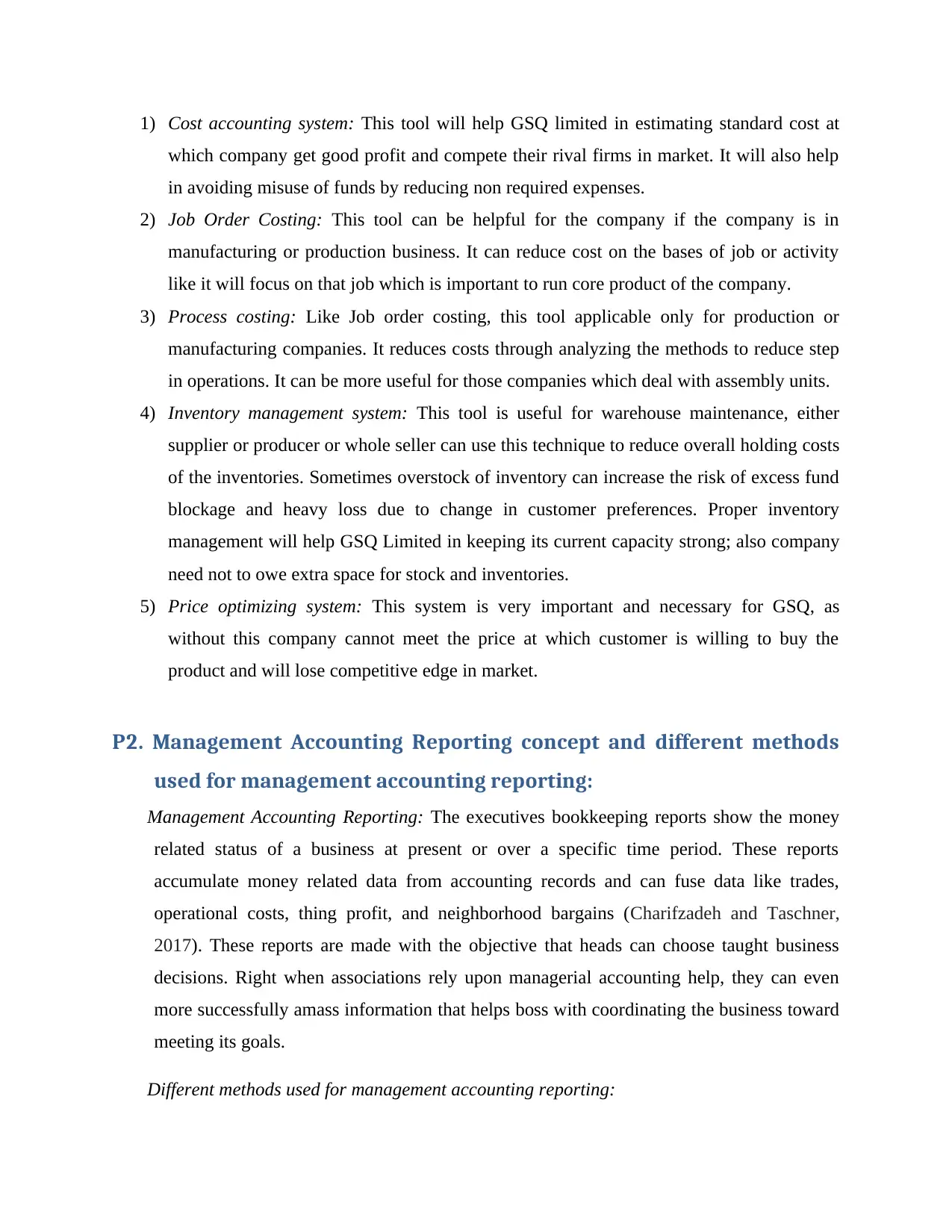
1) Cost accounting system: This tool will help GSQ limited in estimating standard cost at
which company get good profit and compete their rival firms in market. It will also help
in avoiding misuse of funds by reducing non required expenses.
2) Job Order Costing: This tool can be helpful for the company if the company is in
manufacturing or production business. It can reduce cost on the bases of job or activity
like it will focus on that job which is important to run core product of the company.
3) Process costing: Like Job order costing, this tool applicable only for production or
manufacturing companies. It reduces costs through analyzing the methods to reduce step
in operations. It can be more useful for those companies which deal with assembly units.
4) Inventory management system: This tool is useful for warehouse maintenance, either
supplier or producer or whole seller can use this technique to reduce overall holding costs
of the inventories. Sometimes overstock of inventory can increase the risk of excess fund
blockage and heavy loss due to change in customer preferences. Proper inventory
management will help GSQ Limited in keeping its current capacity strong; also company
need not to owe extra space for stock and inventories.
5) Price optimizing system: This system is very important and necessary for GSQ, as
without this company cannot meet the price at which customer is willing to buy the
product and will lose competitive edge in market.
P2. Management Accounting Reporting concept and different methods
used for management accounting reporting:
Management Accounting Reporting: The executives bookkeeping reports show the money
related status of a business at present or over a specific time period. These reports
accumulate money related data from accounting records and can fuse data like trades,
operational costs, thing profit, and neighborhood bargains (Charifzadeh and Taschner,
2017). These reports are made with the objective that heads can choose taught business
decisions. Right when associations rely upon managerial accounting help, they can even
more successfully amass information that helps boss with coordinating the business toward
meeting its goals.
Different methods used for management accounting reporting:
which company get good profit and compete their rival firms in market. It will also help
in avoiding misuse of funds by reducing non required expenses.
2) Job Order Costing: This tool can be helpful for the company if the company is in
manufacturing or production business. It can reduce cost on the bases of job or activity
like it will focus on that job which is important to run core product of the company.
3) Process costing: Like Job order costing, this tool applicable only for production or
manufacturing companies. It reduces costs through analyzing the methods to reduce step
in operations. It can be more useful for those companies which deal with assembly units.
4) Inventory management system: This tool is useful for warehouse maintenance, either
supplier or producer or whole seller can use this technique to reduce overall holding costs
of the inventories. Sometimes overstock of inventory can increase the risk of excess fund
blockage and heavy loss due to change in customer preferences. Proper inventory
management will help GSQ Limited in keeping its current capacity strong; also company
need not to owe extra space for stock and inventories.
5) Price optimizing system: This system is very important and necessary for GSQ, as
without this company cannot meet the price at which customer is willing to buy the
product and will lose competitive edge in market.
P2. Management Accounting Reporting concept and different methods
used for management accounting reporting:
Management Accounting Reporting: The executives bookkeeping reports show the money
related status of a business at present or over a specific time period. These reports
accumulate money related data from accounting records and can fuse data like trades,
operational costs, thing profit, and neighborhood bargains (Charifzadeh and Taschner,
2017). These reports are made with the objective that heads can choose taught business
decisions. Right when associations rely upon managerial accounting help, they can even
more successfully amass information that helps boss with coordinating the business toward
meeting its goals.
Different methods used for management accounting reporting:
⊘ This is a preview!⊘
Do you want full access?
Subscribe today to unlock all pages.

Trusted by 1+ million students worldwide
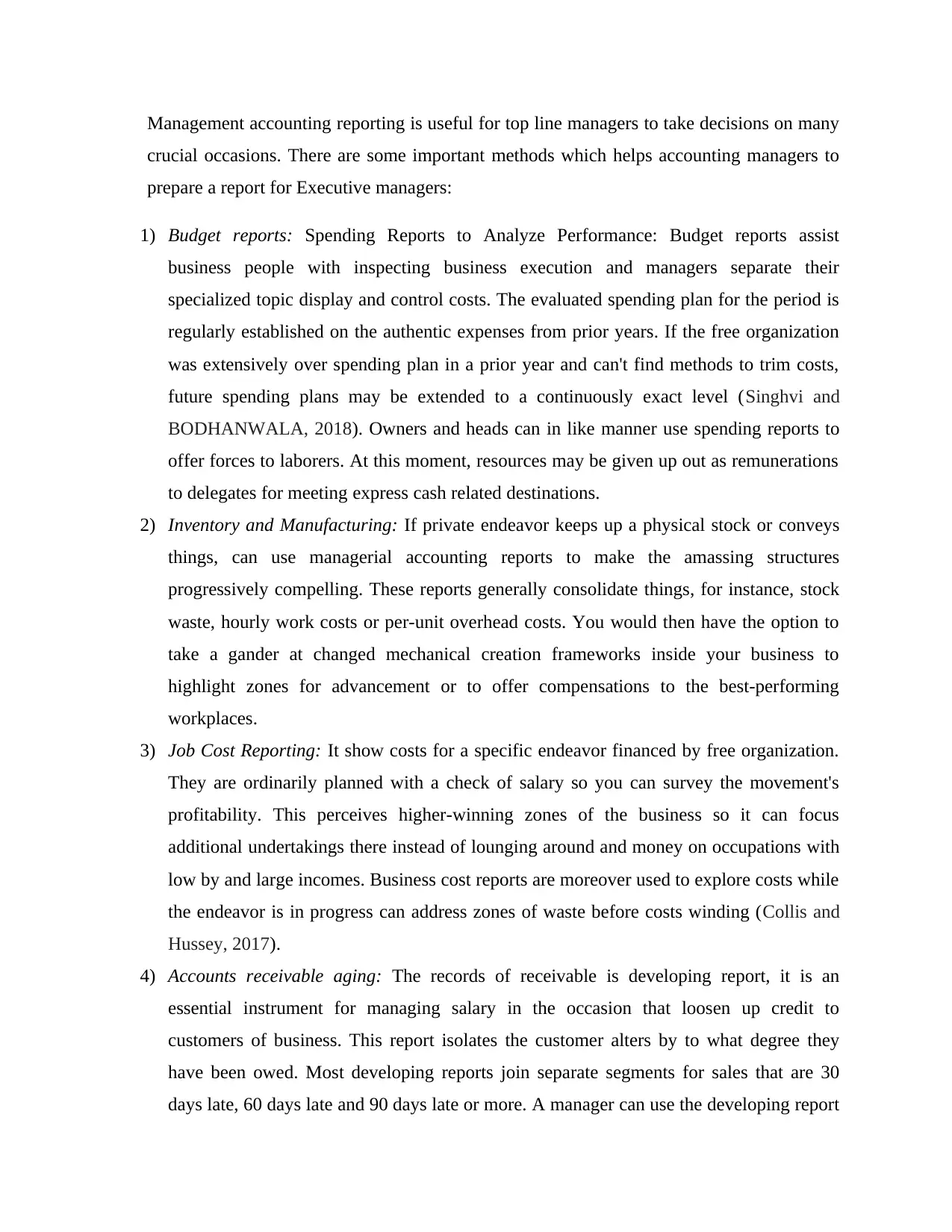
Management accounting reporting is useful for top line managers to take decisions on many
crucial occasions. There are some important methods which helps accounting managers to
prepare a report for Executive managers:
1) Budget reports: Spending Reports to Analyze Performance: Budget reports assist
business people with inspecting business execution and managers separate their
specialized topic display and control costs. The evaluated spending plan for the period is
regularly established on the authentic expenses from prior years. If the free organization
was extensively over spending plan in a prior year and can't find methods to trim costs,
future spending plans may be extended to a continuously exact level (Singhvi and
BODHANWALA, 2018). Owners and heads can in like manner use spending reports to
offer forces to laborers. At this moment, resources may be given up out as remunerations
to delegates for meeting express cash related destinations.
2) Inventory and Manufacturing: If private endeavor keeps up a physical stock or conveys
things, can use managerial accounting reports to make the amassing structures
progressively compelling. These reports generally consolidate things, for instance, stock
waste, hourly work costs or per-unit overhead costs. You would then have the option to
take a gander at changed mechanical creation frameworks inside your business to
highlight zones for advancement or to offer compensations to the best-performing
workplaces.
3) Job Cost Reporting: It show costs for a specific endeavor financed by free organization.
They are ordinarily planned with a check of salary so you can survey the movement's
profitability. This perceives higher-winning zones of the business so it can focus
additional undertakings there instead of lounging around and money on occupations with
low by and large incomes. Business cost reports are moreover used to explore costs while
the endeavor is in progress can address zones of waste before costs winding (Collis and
Hussey, 2017).
4) Accounts receivable aging: The records of receivable is developing report, it is an
essential instrument for managing salary in the occasion that loosen up credit to
customers of business. This report isolates the customer alters by to what degree they
have been owed. Most developing reports join separate segments for sales that are 30
days late, 60 days late and 90 days late or more. A manager can use the developing report
crucial occasions. There are some important methods which helps accounting managers to
prepare a report for Executive managers:
1) Budget reports: Spending Reports to Analyze Performance: Budget reports assist
business people with inspecting business execution and managers separate their
specialized topic display and control costs. The evaluated spending plan for the period is
regularly established on the authentic expenses from prior years. If the free organization
was extensively over spending plan in a prior year and can't find methods to trim costs,
future spending plans may be extended to a continuously exact level (Singhvi and
BODHANWALA, 2018). Owners and heads can in like manner use spending reports to
offer forces to laborers. At this moment, resources may be given up out as remunerations
to delegates for meeting express cash related destinations.
2) Inventory and Manufacturing: If private endeavor keeps up a physical stock or conveys
things, can use managerial accounting reports to make the amassing structures
progressively compelling. These reports generally consolidate things, for instance, stock
waste, hourly work costs or per-unit overhead costs. You would then have the option to
take a gander at changed mechanical creation frameworks inside your business to
highlight zones for advancement or to offer compensations to the best-performing
workplaces.
3) Job Cost Reporting: It show costs for a specific endeavor financed by free organization.
They are ordinarily planned with a check of salary so you can survey the movement's
profitability. This perceives higher-winning zones of the business so it can focus
additional undertakings there instead of lounging around and money on occupations with
low by and large incomes. Business cost reports are moreover used to explore costs while
the endeavor is in progress can address zones of waste before costs winding (Collis and
Hussey, 2017).
4) Accounts receivable aging: The records of receivable is developing report, it is an
essential instrument for managing salary in the occasion that loosen up credit to
customers of business. This report isolates the customer alters by to what degree they
have been owed. Most developing reports join separate segments for sales that are 30
days late, 60 days late and 90 days late or more. A manager can use the developing report
Paraphrase This Document
Need a fresh take? Get an instant paraphrase of this document with our AI Paraphraser
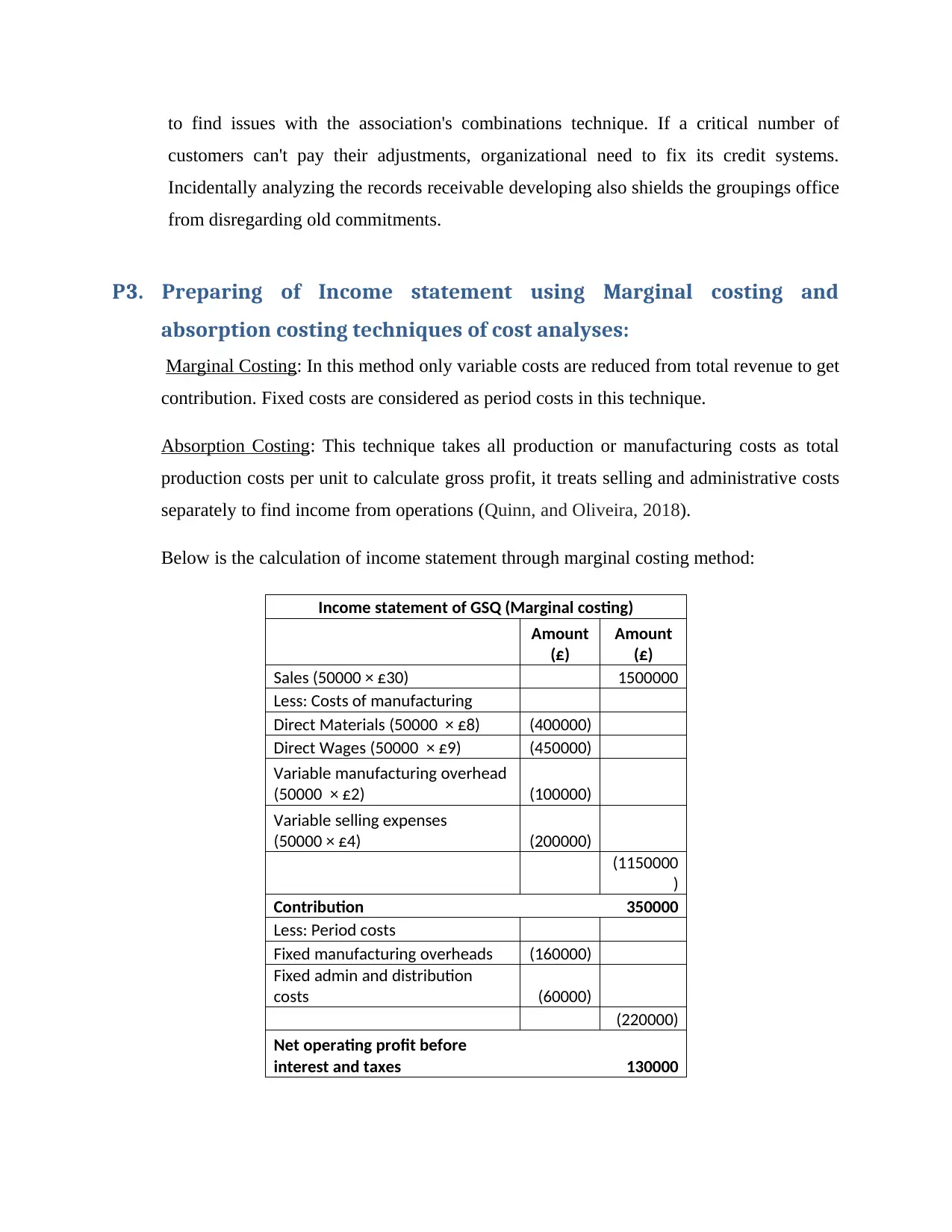
to find issues with the association's combinations technique. If a critical number of
customers can't pay their adjustments, organizational need to fix its credit systems.
Incidentally analyzing the records receivable developing also shields the groupings office
from disregarding old commitments.
P3. Preparing of Income statement using Marginal costing and
absorption costing techniques of cost analyses:
Marginal Costing: In this method only variable costs are reduced from total revenue to get
contribution. Fixed costs are considered as period costs in this technique.
Absorption Costing: This technique takes all production or manufacturing costs as total
production costs per unit to calculate gross profit, it treats selling and administrative costs
separately to find income from operations (Quinn, and Oliveira, 2018).
Below is the calculation of income statement through marginal costing method:
Income statement of GSQ (Marginal costing)
Amount
(£)
Amount
(£)
Sales (50000 × £30) 1500000
Less: Costs of manufacturing
Direct Materials (50000 × £8) (400000)
Direct Wages (50000 × £9) (450000)
Variable manufacturing overhead
(50000 × £2) (100000)
Variable selling expenses
(50000 × £4) (200000)
(1150000
)
Contribution 350000
Less: Period costs
Fixed manufacturing overheads (160000)
Fixed admin and distribution
costs (60000)
(220000)
Net operating profit before
interest and taxes 130000
customers can't pay their adjustments, organizational need to fix its credit systems.
Incidentally analyzing the records receivable developing also shields the groupings office
from disregarding old commitments.
P3. Preparing of Income statement using Marginal costing and
absorption costing techniques of cost analyses:
Marginal Costing: In this method only variable costs are reduced from total revenue to get
contribution. Fixed costs are considered as period costs in this technique.
Absorption Costing: This technique takes all production or manufacturing costs as total
production costs per unit to calculate gross profit, it treats selling and administrative costs
separately to find income from operations (Quinn, and Oliveira, 2018).
Below is the calculation of income statement through marginal costing method:
Income statement of GSQ (Marginal costing)
Amount
(£)
Amount
(£)
Sales (50000 × £30) 1500000
Less: Costs of manufacturing
Direct Materials (50000 × £8) (400000)
Direct Wages (50000 × £9) (450000)
Variable manufacturing overhead
(50000 × £2) (100000)
Variable selling expenses
(50000 × £4) (200000)
(1150000
)
Contribution 350000
Less: Period costs
Fixed manufacturing overheads (160000)
Fixed admin and distribution
costs (60000)
(220000)
Net operating profit before
interest and taxes 130000
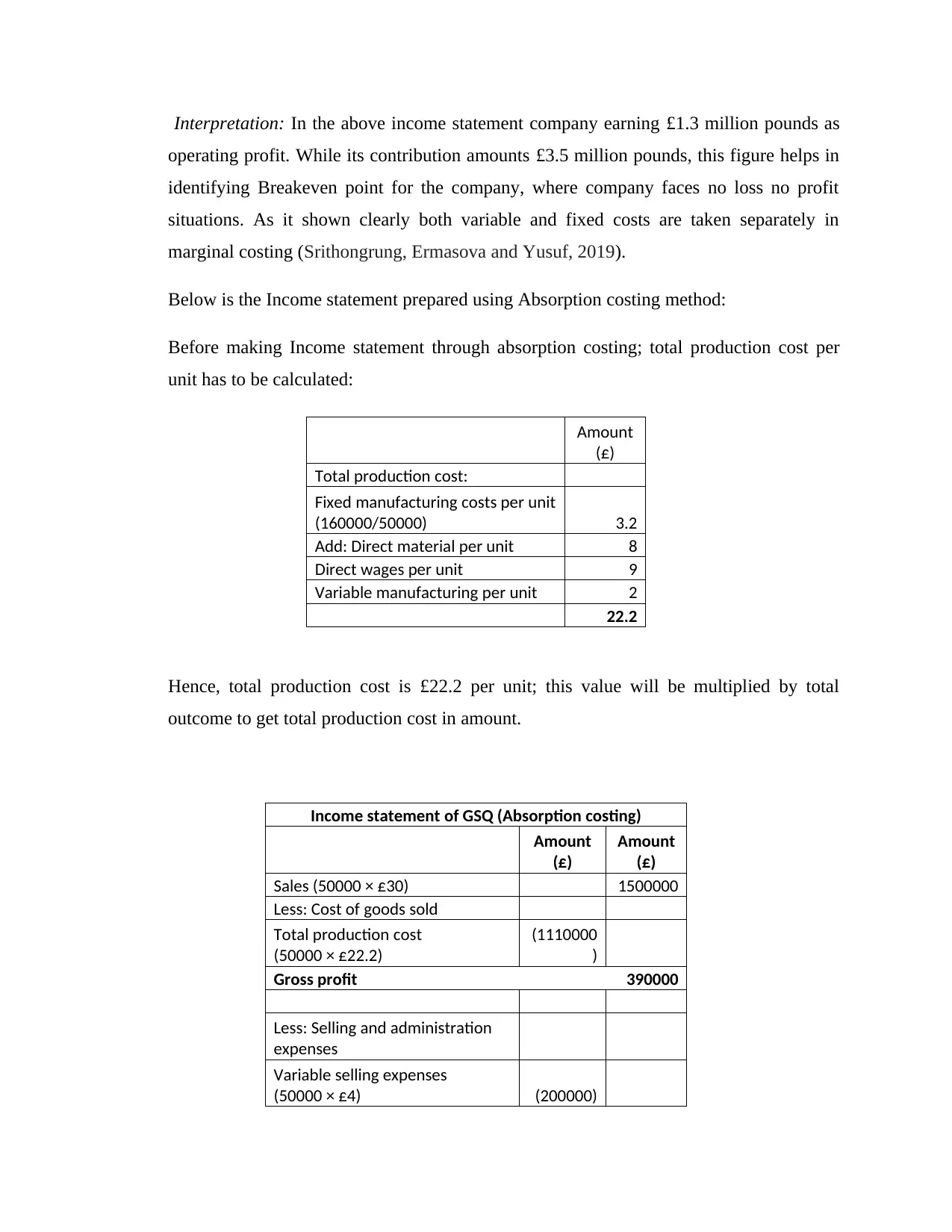
Interpretation: In the above income statement company earning £1.3 million pounds as
operating profit. While its contribution amounts £3.5 million pounds, this figure helps in
identifying Breakeven point for the company, where company faces no loss no profit
situations. As it shown clearly both variable and fixed costs are taken separately in
marginal costing (Srithongrung, Ermasova and Yusuf, 2019).
Below is the Income statement prepared using Absorption costing method:
Before making Income statement through absorption costing; total production cost per
unit has to be calculated:
Amount
(£)
Total production cost:
Fixed manufacturing costs per unit
(160000/50000) 3.2
Add: Direct material per unit 8
Direct wages per unit 9
Variable manufacturing per unit 2
22.2
Hence, total production cost is £22.2 per unit; this value will be multiplied by total
outcome to get total production cost in amount.
Income statement of GSQ (Absorption costing)
Amount
(£)
Amount
(£)
Sales (50000 × £30) 1500000
Less: Cost of goods sold
Total production cost
(50000 × £22.2)
(1110000
)
Gross profit 390000
Less: Selling and administration
expenses
Variable selling expenses
(50000 × £4) (200000)
operating profit. While its contribution amounts £3.5 million pounds, this figure helps in
identifying Breakeven point for the company, where company faces no loss no profit
situations. As it shown clearly both variable and fixed costs are taken separately in
marginal costing (Srithongrung, Ermasova and Yusuf, 2019).
Below is the Income statement prepared using Absorption costing method:
Before making Income statement through absorption costing; total production cost per
unit has to be calculated:
Amount
(£)
Total production cost:
Fixed manufacturing costs per unit
(160000/50000) 3.2
Add: Direct material per unit 8
Direct wages per unit 9
Variable manufacturing per unit 2
22.2
Hence, total production cost is £22.2 per unit; this value will be multiplied by total
outcome to get total production cost in amount.
Income statement of GSQ (Absorption costing)
Amount
(£)
Amount
(£)
Sales (50000 × £30) 1500000
Less: Cost of goods sold
Total production cost
(50000 × £22.2)
(1110000
)
Gross profit 390000
Less: Selling and administration
expenses
Variable selling expenses
(50000 × £4) (200000)
⊘ This is a preview!⊘
Do you want full access?
Subscribe today to unlock all pages.

Trusted by 1+ million students worldwide
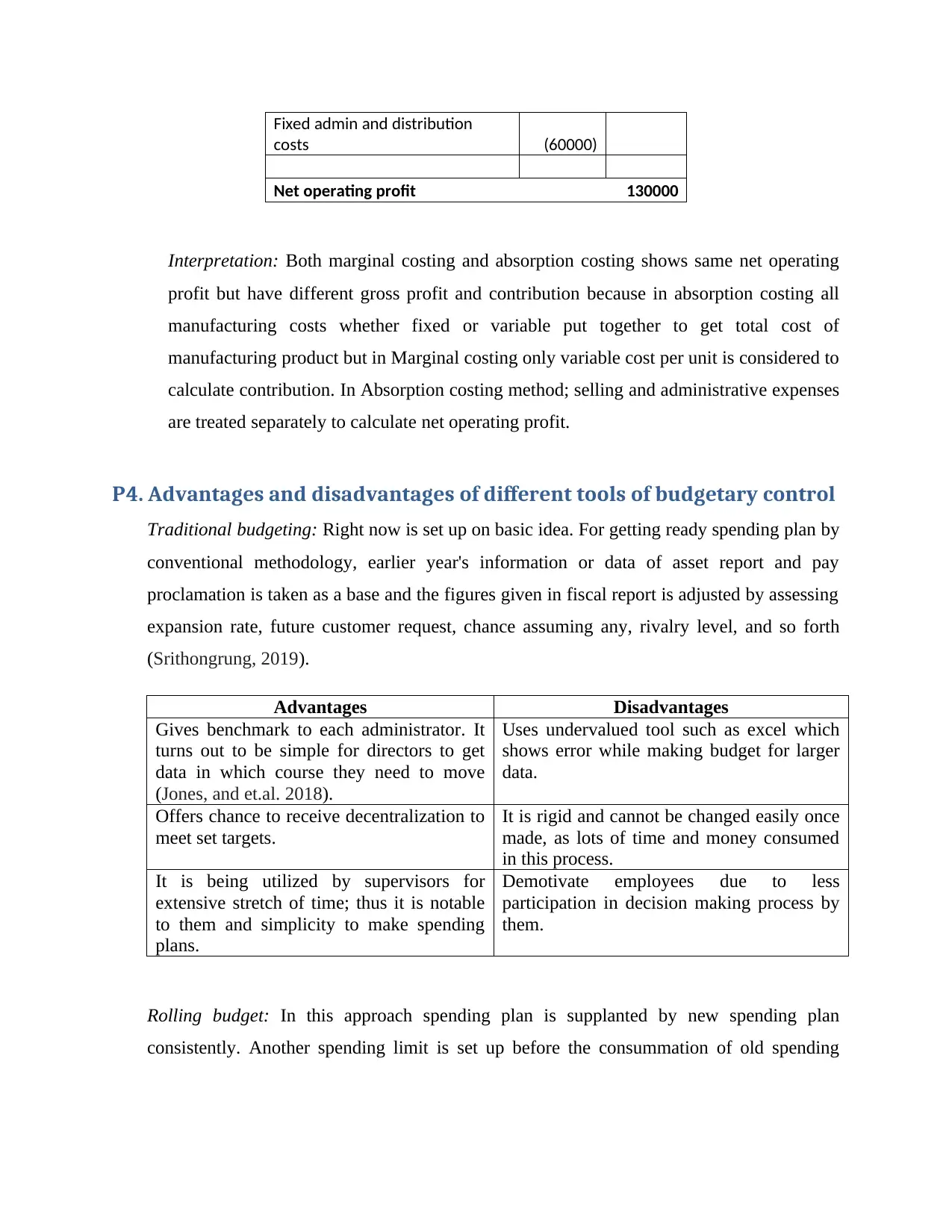
Fixed admin and distribution
costs (60000)
Net operating profit 130000
Interpretation: Both marginal costing and absorption costing shows same net operating
profit but have different gross profit and contribution because in absorption costing all
manufacturing costs whether fixed or variable put together to get total cost of
manufacturing product but in Marginal costing only variable cost per unit is considered to
calculate contribution. In Absorption costing method; selling and administrative expenses
are treated separately to calculate net operating profit.
P4. Advantages and disadvantages of different tools of budgetary control
Traditional budgeting: Right now is set up on basic idea. For getting ready spending plan by
conventional methodology, earlier year's information or data of asset report and pay
proclamation is taken as a base and the figures given in fiscal report is adjusted by assessing
expansion rate, future customer request, chance assuming any, rivalry level, and so forth
(Srithongrung, 2019).
Advantages Disadvantages
Gives benchmark to each administrator. It
turns out to be simple for directors to get
data in which course they need to move
(Jones, and et.al. 2018).
Uses undervalued tool such as excel which
shows error while making budget for larger
data.
Offers chance to receive decentralization to
meet set targets.
It is rigid and cannot be changed easily once
made, as lots of time and money consumed
in this process.
It is being utilized by supervisors for
extensive stretch of time; thus it is notable
to them and simplicity to make spending
plans.
Demotivate employees due to less
participation in decision making process by
them.
Rolling budget: In this approach spending plan is supplanted by new spending plan
consistently. Another spending limit is set up before the consummation of old spending
costs (60000)
Net operating profit 130000
Interpretation: Both marginal costing and absorption costing shows same net operating
profit but have different gross profit and contribution because in absorption costing all
manufacturing costs whether fixed or variable put together to get total cost of
manufacturing product but in Marginal costing only variable cost per unit is considered to
calculate contribution. In Absorption costing method; selling and administrative expenses
are treated separately to calculate net operating profit.
P4. Advantages and disadvantages of different tools of budgetary control
Traditional budgeting: Right now is set up on basic idea. For getting ready spending plan by
conventional methodology, earlier year's information or data of asset report and pay
proclamation is taken as a base and the figures given in fiscal report is adjusted by assessing
expansion rate, future customer request, chance assuming any, rivalry level, and so forth
(Srithongrung, 2019).
Advantages Disadvantages
Gives benchmark to each administrator. It
turns out to be simple for directors to get
data in which course they need to move
(Jones, and et.al. 2018).
Uses undervalued tool such as excel which
shows error while making budget for larger
data.
Offers chance to receive decentralization to
meet set targets.
It is rigid and cannot be changed easily once
made, as lots of time and money consumed
in this process.
It is being utilized by supervisors for
extensive stretch of time; thus it is notable
to them and simplicity to make spending
plans.
Demotivate employees due to less
participation in decision making process by
them.
Rolling budget: In this approach spending plan is supplanted by new spending plan
consistently. Another spending limit is set up before the consummation of old spending
Paraphrase This Document
Need a fresh take? Get an instant paraphrase of this document with our AI Paraphraser
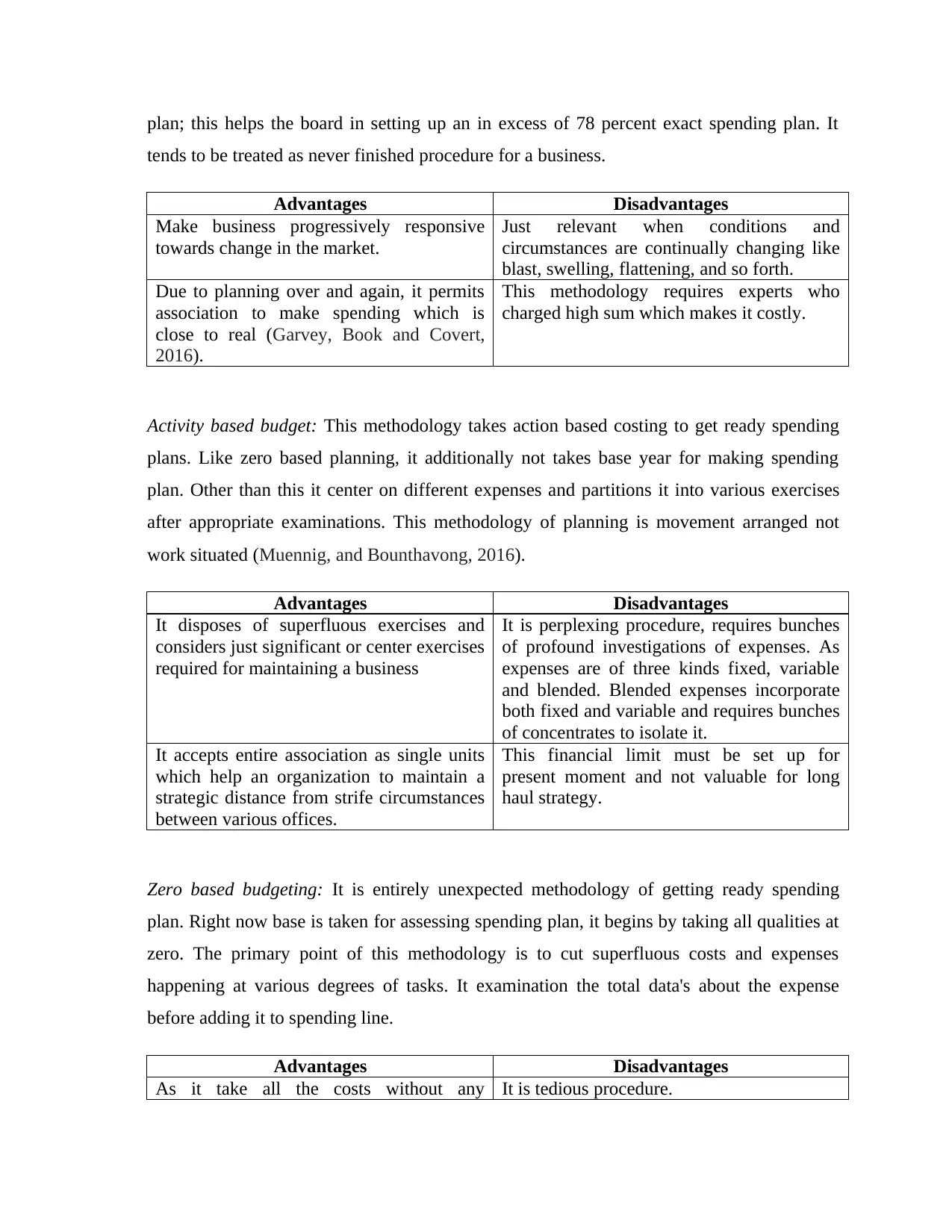
plan; this helps the board in setting up an in excess of 78 percent exact spending plan. It
tends to be treated as never finished procedure for a business.
Advantages Disadvantages
Make business progressively responsive
towards change in the market.
Just relevant when conditions and
circumstances are continually changing like
blast, swelling, flattening, and so forth.
Due to planning over and again, it permits
association to make spending which is
close to real (Garvey, Book and Covert,
2016).
This methodology requires experts who
charged high sum which makes it costly.
Activity based budget: This methodology takes action based costing to get ready spending
plans. Like zero based planning, it additionally not takes base year for making spending
plan. Other than this it center on different expenses and partitions it into various exercises
after appropriate examinations. This methodology of planning is movement arranged not
work situated (Muennig, and Bounthavong, 2016).
Advantages Disadvantages
It disposes of superfluous exercises and
considers just significant or center exercises
required for maintaining a business
It is perplexing procedure, requires bunches
of profound investigations of expenses. As
expenses are of three kinds fixed, variable
and blended. Blended expenses incorporate
both fixed and variable and requires bunches
of concentrates to isolate it.
It accepts entire association as single units
which help an organization to maintain a
strategic distance from strife circumstances
between various offices.
This financial limit must be set up for
present moment and not valuable for long
haul strategy.
Zero based budgeting: It is entirely unexpected methodology of getting ready spending
plan. Right now base is taken for assessing spending plan, it begins by taking all qualities at
zero. The primary point of this methodology is to cut superfluous costs and expenses
happening at various degrees of tasks. It examination the total data's about the expense
before adding it to spending line.
Advantages Disadvantages
As it take all the costs without any It is tedious procedure.
tends to be treated as never finished procedure for a business.
Advantages Disadvantages
Make business progressively responsive
towards change in the market.
Just relevant when conditions and
circumstances are continually changing like
blast, swelling, flattening, and so forth.
Due to planning over and again, it permits
association to make spending which is
close to real (Garvey, Book and Covert,
2016).
This methodology requires experts who
charged high sum which makes it costly.
Activity based budget: This methodology takes action based costing to get ready spending
plans. Like zero based planning, it additionally not takes base year for making spending
plan. Other than this it center on different expenses and partitions it into various exercises
after appropriate examinations. This methodology of planning is movement arranged not
work situated (Muennig, and Bounthavong, 2016).
Advantages Disadvantages
It disposes of superfluous exercises and
considers just significant or center exercises
required for maintaining a business
It is perplexing procedure, requires bunches
of profound investigations of expenses. As
expenses are of three kinds fixed, variable
and blended. Blended expenses incorporate
both fixed and variable and requires bunches
of concentrates to isolate it.
It accepts entire association as single units
which help an organization to maintain a
strategic distance from strife circumstances
between various offices.
This financial limit must be set up for
present moment and not valuable for long
haul strategy.
Zero based budgeting: It is entirely unexpected methodology of getting ready spending
plan. Right now base is taken for assessing spending plan, it begins by taking all qualities at
zero. The primary point of this methodology is to cut superfluous costs and expenses
happening at various degrees of tasks. It examination the total data's about the expense
before adding it to spending line.
Advantages Disadvantages
As it take all the costs without any It is tedious procedure.
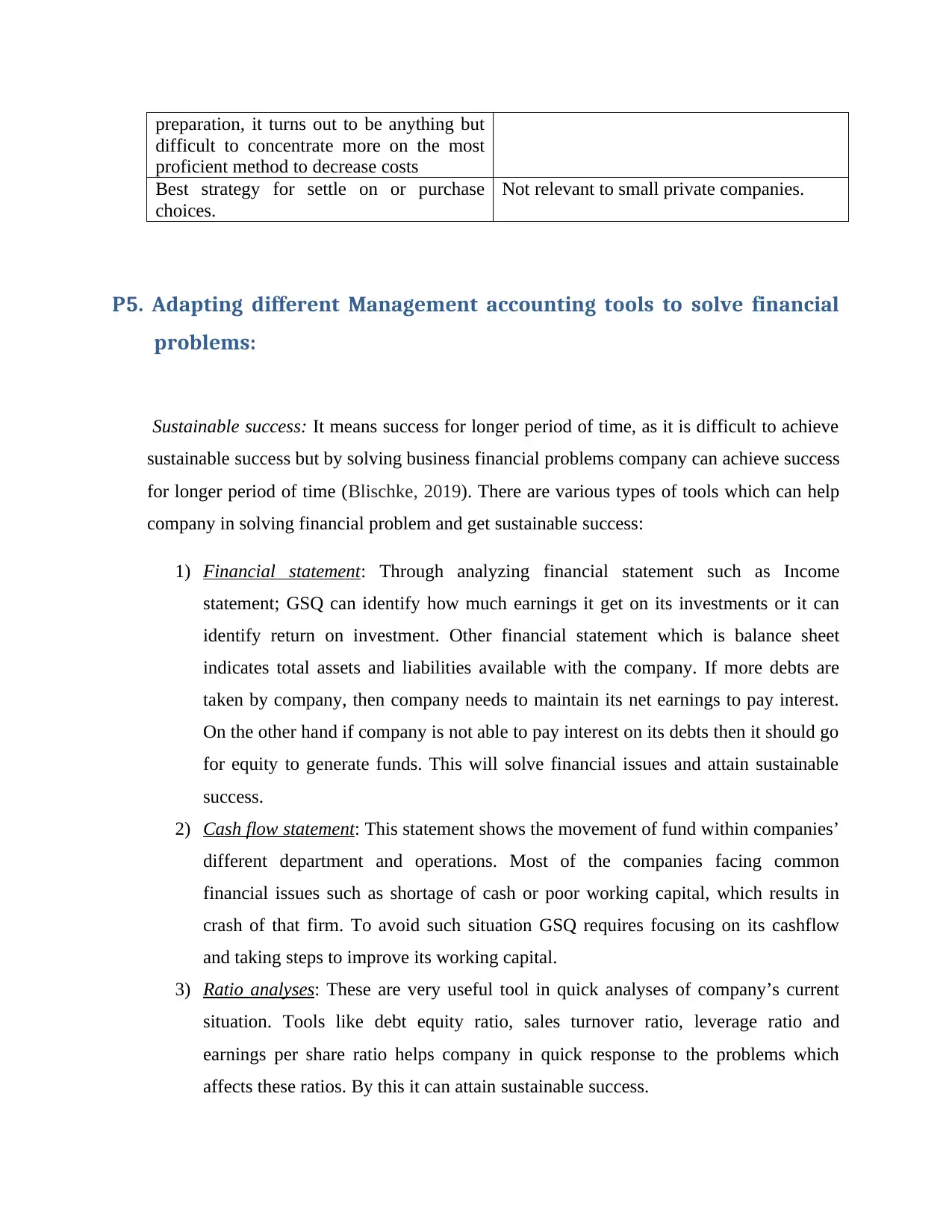
preparation, it turns out to be anything but
difficult to concentrate more on the most
proficient method to decrease costs
Best strategy for settle on or purchase
choices.
Not relevant to small private companies.
P5. Adapting different Management accounting tools to solve financial
problems:
Sustainable success: It means success for longer period of time, as it is difficult to achieve
sustainable success but by solving business financial problems company can achieve success
for longer period of time (Blischke, 2019). There are various types of tools which can help
company in solving financial problem and get sustainable success:
1) Financial statement: Through analyzing financial statement such as Income
statement; GSQ can identify how much earnings it get on its investments or it can
identify return on investment. Other financial statement which is balance sheet
indicates total assets and liabilities available with the company. If more debts are
taken by company, then company needs to maintain its net earnings to pay interest.
On the other hand if company is not able to pay interest on its debts then it should go
for equity to generate funds. This will solve financial issues and attain sustainable
success.
2) Cash flow statement: This statement shows the movement of fund within companies’
different department and operations. Most of the companies facing common
financial issues such as shortage of cash or poor working capital, which results in
crash of that firm. To avoid such situation GSQ requires focusing on its cashflow
and taking steps to improve its working capital.
3) Ratio analyses: These are very useful tool in quick analyses of company’s current
situation. Tools like debt equity ratio, sales turnover ratio, leverage ratio and
earnings per share ratio helps company in quick response to the problems which
affects these ratios. By this it can attain sustainable success.
difficult to concentrate more on the most
proficient method to decrease costs
Best strategy for settle on or purchase
choices.
Not relevant to small private companies.
P5. Adapting different Management accounting tools to solve financial
problems:
Sustainable success: It means success for longer period of time, as it is difficult to achieve
sustainable success but by solving business financial problems company can achieve success
for longer period of time (Blischke, 2019). There are various types of tools which can help
company in solving financial problem and get sustainable success:
1) Financial statement: Through analyzing financial statement such as Income
statement; GSQ can identify how much earnings it get on its investments or it can
identify return on investment. Other financial statement which is balance sheet
indicates total assets and liabilities available with the company. If more debts are
taken by company, then company needs to maintain its net earnings to pay interest.
On the other hand if company is not able to pay interest on its debts then it should go
for equity to generate funds. This will solve financial issues and attain sustainable
success.
2) Cash flow statement: This statement shows the movement of fund within companies’
different department and operations. Most of the companies facing common
financial issues such as shortage of cash or poor working capital, which results in
crash of that firm. To avoid such situation GSQ requires focusing on its cashflow
and taking steps to improve its working capital.
3) Ratio analyses: These are very useful tool in quick analyses of company’s current
situation. Tools like debt equity ratio, sales turnover ratio, leverage ratio and
earnings per share ratio helps company in quick response to the problems which
affects these ratios. By this it can attain sustainable success.
⊘ This is a preview!⊘
Do you want full access?
Subscribe today to unlock all pages.

Trusted by 1+ million students worldwide
1 out of 14
Related Documents
Your All-in-One AI-Powered Toolkit for Academic Success.
+13062052269
info@desklib.com
Available 24*7 on WhatsApp / Email
![[object Object]](/_next/static/media/star-bottom.7253800d.svg)
Unlock your academic potential
Copyright © 2020–2025 A2Z Services. All Rights Reserved. Developed and managed by ZUCOL.





